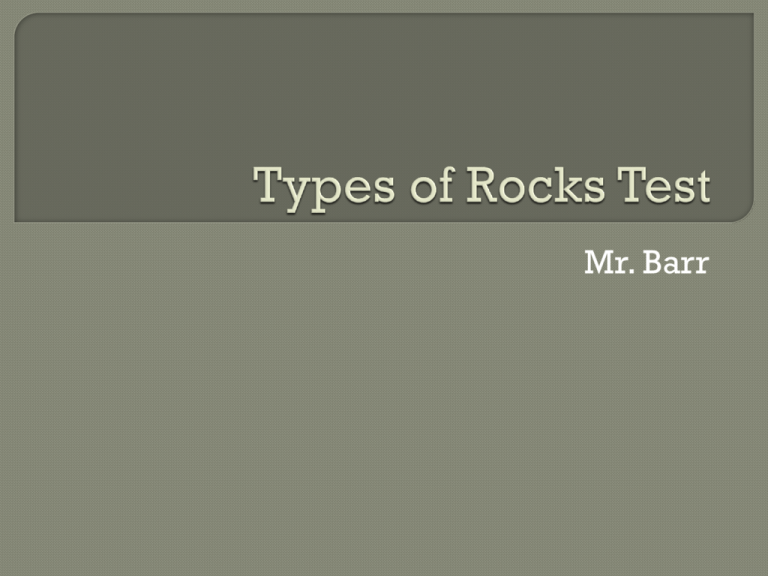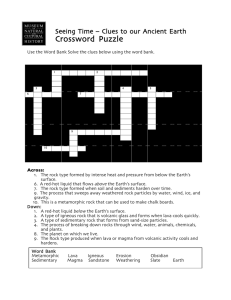Types of Rocks
advertisement

Mr. Barr When sediments are compacted and cemented together, this type of rock is formed. A. Sediments B. Sedimentary C. Metamorphic D. Igneous E. Magma A rock exposed to high heat and pressure can change form and turn into this type of rock. A. Sediments B. Sedimentary C. Metamorphic D. Igneous E. Magma Any rock can be mechanically or chemically broken down into pieces called _________________. A. Sediments B. Sedimentary Rock C. Metamorphic Rock D. Igneous Rock E. Magma When magma cools and crystallizes this type of rock forms. A. Sediments B. Sedimentary C. Metamorphic D. Igneous E. Magma When the melting point of the minerals in a rock are reached ______________ will form. A. Sediments B. Sedimentary Rock C. Metamorphic Rock D. Igneous Rock E. Magma A rock formed from cemented pieces of preexisting rock is called a(n) ______________ sedimentary rock. A. Clastic B. Chemical C. Biologic D. Organic E. Intrusive Magma that cools in the ground will form a(n) _________________ igneous rock. A. Foliated B. Non-foliated C. Intrusive D. Extrusive E. Chemical When rock is exposed to great pressure the minerals can separate into bands or layers to create a(n) _________________ metamorphic rock. A. Foliated B. Non-foliated C. Intrusive D. Extrusive E. Chemical Some rocks form from the minerals in water precipitating (coming together). This type of rock is called a(n) ________________ sedimentary rock. A. Clastic B. Chemical C. Biologic D. Organic E. Intrusive When lava cools at the surface of a volcano or at a mid-ocean ridge, a(n) _________________ igneous rock will form. A. Foliated B. Non-foliated C. Intrusive D. Extrusive E. Chemical When a rock forms from the remains of living organisms it is called an organic or _______________ sedimentary rock. A. Clastic B. Chemical C. Biologic D. Foliated E. Intrusive When a rock is exposed to high heat and pressure and only one type of mineral is present in the rock, a(n) ______________________ metamorphic rock will generally form. A. Foliated B. Non-foliated C. Intrusive D. Extrusive E. Chemical What mineral is found in Great Salt Lake in Utah? A. Carbon B. Gypsum C. Dolomite D. Halite E. Calcite Southern Florida is home to many coral reefs and marine life. What type of rock is formed? A. Conglomerate B. Rock Salt C. Sandstone D. Limestone E. Shale What sedimentary rock is shown above? A. Conglomerate B. Breccia C. Sandstone D. Limestone E. Shale The rock with the smallest clastic grain size is ___________________. A. Conglomerate B. Breccia C. Sandstone D. Limestone E. Shale What metamorphic rock is shown above? A. Quartzite B. Marble C. Anthracite Coal D. Gneiss E. Schist If shale is exposed to as much heat and pressure as possible, what is the last metamorphic rock that it could become? A. Slate B. Gneiss C. Schist D. Metaconglomerate E. Anthracite Coal If the rock shown above were exposed to high heat and pressure, what type of rock would it change into? A. Quartzite B. Marble C. Metaconglomerate D. Gneiss E. Anthracite Coal Quartzite is found on our mountain peaks. What does this suggest could have existed here a long time ago? A. A beach B. A swamp C. A tropical rain forest D. Dinosaurs E. Wooly mammoths Which mineral below will melt (or crystallize) at the lowest temperature? A. Anorthite B. Horneblende C. Muscovite D. Biotite E. Orthoclase Basalt’s dark color is attributed to the large portions of magnesium and iron it contains. What mineral would you expect to find in basalt? A. Orthoclase B. Olivine C. Albite D. Quartz E. Muscovite As magma under a volcano cools, which of the following rocks would crystallize first? A. Gabbro B. Diorite C. Granite D. Biotite Which mineral below would be the first to melt as it is heated up? A. Amphibole B. Olivine C. Potassium feldspar D. Sodium rich plagioclase E. Pyroxene If magma containing a lot of quartz cools slowly, the igneous rock _______________ will form. A. Rhyolite B. Diorite C. Basalt D. Pumice E. Granite Igneous rocks with a low silica (or quartz) content are called mafic while rocks with a high silica content are called ________________. A. Coarse B. Felsic C. Fine D. Ultramafic E. Vesicular The term that refers to “trapped gases” within the rock is ____________________. A. Vesicular B. Felsic C. Mafic D. Glassy E. Coarse The igneous rock with the fastest cooling rate is known as ____________________. A. Andesite B. Scoria C. Obsidian D. Peridotite E. Granite An extrusive, mafic igneous rock making up the surface of the ocean floor is ___________________. A. Gabbro B. Basalt C. Obsidian D. Scoria E. Granite Which description best describes rhyolite? A. Low quartz content and cooled quickly B. High quartz content and cooled quickly C. Low quartz content and cooled slowly D. High quartz content and cooled slowly What igneous rock is this? A. Marble B. Quartzite C. Basalt D. Granite E. Gneiss What description best describes this igneous rock? A. Intrusive and slow cooling rate B. Intrusive and fast cooling rate C. Extrusive and slow cooling rate D. Extrusive and fast cooling rate What extrusive igneous rock is this? A. Marble B. Quartzite C. Basalt D. Granite E. Gneiss Where does this rock form? A. In the mountains B. In rivers C. Underneath the ocean crust D. In caves E. In swamps What is the name of this igneous rock? A. Marble B. Pumice C. Basalt D. Limestone E. Obsidian What is the name of this nonfoliated metamorphic rock? A. Marble B. Quartzite C. Limestone D. Granite E. Gneiss This nonfoliated metamorphic rock formed from sandstone. What is it? A. Marble B. Quartzite C. Basalt D. Granite E. Gneiss This metamorphic rock exhibits foliation. What is the name of this rock? A. Marble B. Quartzite C. Slate D. Granite E. Gneiss This clastic sedimentary rock makes up large portions of the desert southwest of the United States. A. Conglomerate B. Breccia C. Sandstone D. Limestone E. Shale What is the name of this clastic sedimentary rock that is found all around the Wilson campus? A. Conglomerate B. Breccia C. Sandstone D. Limestone E. Shale What is the name of this metamorphic rock? A. Marble B. Quartzite C. Slate D. Shale E. Gneiss What is the name of this clastic sedimentary rock? A. Conglomerate B. Breccia C. Sandstone D. Limestone E. Shale This sedimentary rock is found throughout the Shenandoah Valley. What rock type is shown above? A. Conglomerate B. Marble C. Sandstone D. Limestone E. Shale What igneous rock is shown above? A. Rhyolite B. Scoria C. Basalt D. Pumice E. Granite Which rock would you expect to find in the sea shown above? A. Coal B. Basalt C. Sandstone D. Granite E. Schist According to the diagram, what type of metamorphic rock might lime (calcium) mud turn into? A. Marble B. Quartzite C. Slate D. Schist E. Gneiss What type of rock would form at position I? A. Foliated Metamorphic B. Intrusive Igneous C. Nonfoliated metamorphic D. Extrusive Igneous E. Sedimentary What is the name of this igneous rock? A. Obsidian B. Scoria C. Basalt D. Pumice E. Granite What type of rock is fracking done on? A. Igneous B. Sedimentary C. Metamorphic D. Magma E. None of the above In which environment would you most likely NOT find igneous rocks? A. Mid-Atlantic Ridge B. Mt. St. Helens C. Hawaii D. Great Plains E. Aleutian Islands





